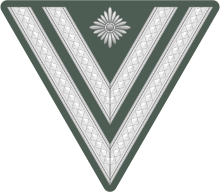Stabsgefreiter
Stabsgefreiter (abbr. StGefr, on lits SG) is the second highest rank of enlisted men in the German Bundeswehr,[1] which might be comparable to specialist (OR-4b) in Anglophone armed forces.[2]



| Stabsgefreiter | |
|---|---|
  Heer shoulder and Marine sleeve insignia | |
| Country | |
| Service branch | |
| Abbreviation | StGefr. |
| Rank | German enlisted rank |
| NATO rank | OR-4 |
| Non-NATO rank | E-4 |
| Formation | 1957 |
| Next higher rank | Oberstabsgefreiter |
| Next lower rank | Hauptgefreiter |
History
In the 19th century German Army the OR2-rank Gefreiter (plural: Gefreite) always belonged to the rank group of enlisted men (below noncommissioned (NCO) level). However, during training and fatigue duty Gefreite were competent, authorized, and tasked to act on behalf of NCOs. So Gefreite became the first superior rank above the lowest-level privates. Nevertheless, until 1853 there were no special rank insignia for Gefreiter. In contrast, from 1811–1853 the Vize-Unteroffizier (deputy sergeant) wore the NCO Portepee (sword-knot).
In 1846 the rank of Obergefreiter (OR3; en: 1st/Senior Gefreiter) was introduced. This rank was shown by the so-called sergeant's button on the collar and the NCO Portepee on the sword. From 1853–1919 promotion to Obergefreiter was suspended with the exception of the Fussartillerie (foot artillery).
In the early German Reichswehr the ranks of Gefreiter and "Obergefreiter" were both indicated by one identical horizontal 9 mm Tressenstreifen" (lace stripe) on both upper arms of the uniform jacket.
Regarding regular 12 years duty time from 1921 onwards, the newly introduced ranks of enlisted men (Oberschütze (1st/Senior rifleman (OR-1a)) and Stabsgefreiter (OR-4; Staff Gefreiter) were indicated by angular cuff chevrons on the left upper arm. The sequence of ranks of enlisted men was now as follows:
- Oberschütze (OR-1a, one chevron, in 1935 replaced by a pip)
- Gefreiter (OR-2, one chevron)
- Obergefreiter over 6 years of service (OR-3b, one chevron, one pip)
- Obergefreiter under 6 years of service, (OR-3b, two chevrons)
- Stabsgefreiter (OR-4b, two chevrons, one pip)[3]
- Matrosenoberstabsgefreiter (OR-4a), introduced by the Kriegsmarine in 1940

| Waffen-SS | Heer (Army) | Luftwaffe (Air Force) | Kriegsmarine (Navy) |
|---|---|---|---|
| SS-Schütze | Soldat | Flieger | Matrose |
| SS-Oberschütze | Oberschütze | ||
| SS-Sturmmann | Gefreiter | Matrosengefreiter | |
| SS-Rottenführer | Obergefreiter | Matrosenobergefreiter | |
| No equivalent | Hauptgefreiter | Matrosenhauptgefreiter | |
| No equivalent | Stabsgefreiter | Matrosenstabsgefreiter | |
| No equivalent | Matrosenoberstabsgefreiter | ||
National People's Army
In the GDR National People's Army the rank Stabsgefreiter was OR-3 as well and used until 1990. The equivalent of the Volksmarine was Stabsmatrose.
- See also main articles
Bundeswehr
A soldier of the German Bundeswehr might be promoted from OR1 Soldat (en: private) to Stabsgefreiter OR4b after a regular service time of 36 months.
| Junior rank Hauptgefreiter (OR3a) |
(German enlisted men rank) |
Senior rank Oberstabsgefreiter (OR4a) |
External links
References
- BROCKHAUS, The encyclopedia in 24 volumes (1796–2001), Volume 20: 3-7653-3680-7, page 700.
- Official Website (Bundeswehr): Dienstgrade und Uniformen der Bundeswehr (Service Ranks and Uniforms of the German Federal Defence Forces), in German.
- Word and tradition in the German Army, by Transfeldt – v. Brand – Quenstedt, 6th increased edition, Hamburg 11 H.G. Schulz 1967, p. 48(§68).